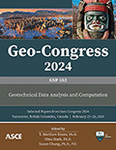Modelling of Strip Footing Problems Using Consistent Particle Method
Publication: Geo-Congress 2024
ABSTRACT
The consistent particle method (CPM) is a Lagrangian particle method initially proposed for solving fluid dynamics problems and has recently been expanded to the area of solid mechanics. The governing equations for mass conservation and dynamics of particles are solved with a predictor-corrector approach. The spatial derivatives of variables (e.g., velocities and stresses) are computed by Taylor series expansion. The physical material density is directly calculated without using the number density of particle. In addition, no extra particles are required to model boundary conditions. For partially loaded boundary surface, the stress singularity problem because of sudden stress change is overcome by the inverse distance weighting method. Numerical examples of bearing capacity of strip footing as well as large deformation penetration of strip footing are presented to show CPM’s abilities to handle geomechanics problems.
Get full access to this article
View all available purchase options and get full access to this chapter.
REFERENCES
Chow, Y. K., Li, S., and Koh, C. G. (2019). “A particle method for simulation of submarine landslides and mudflows.” Proc., 29th ISOPE Conf., Honolulu. Hawaii, USA, ISOPE-I-19-594.
Courant, R., Friedrichs, K., and Lewy, H. (1967). “On the partial difference equations of mathematical physics.” IBM J. Res. Dev., 11(2), 215–234 (English translation of the 1928 German original).
da Silva, M. V., Krabbenhoft, K., Lyamin, A. V., and Sloan, S. W. (2011). “Rigid-plastic large-plasticican analysis of geotechnical penetration problems.” Proc., 13th IACMAG Conf., Univ. of New South Wales, Centre for Infrastructure Engineering and Safety, New South Wales, Australia, Vol. 1, 42–47.
Gingold, R. A., and Monaghan, J. J. (1977). “Smoothed particle hydrodynamics: theory and application to non-spherical stars.” Mon. Not. R. Astron. Soc., 181(3), 375–389.
Jin, Y. F., Yuan, W. H., Yin, Z. Y., and Cheng, Y. M. (2019). “An edge-based strain smoothing particle finite element method for large deformation problems in geotechnical engineering.” Int. J. Numer. Anal. Methods Geomech., 44, 923–941.
Kardani, M., Nazem, M., Carter, J. P., and Abbo, A. J. (2015). “Efficiency of high-order elements in large deformation problems of geomechanics.” Int. J. Geomech., 15(6), 04014101.
Koh, C. G., Gao, M., and Luo, C. (2012). “A new particle method for simulation of incompressible free surface flow problems.” Int. J. Numer. Methods Eng., 89(12), 1582–1604.
Koh, C. G., Luo, M., Gao, M., and Bai, W. (2013). “Modelling of liquid sloshing with constrained floating baffle.” Comput. Struct., 122, 270–279.
Koshizuka, S., Nobe, A., and Oka, Y. (1998). “Numerical analysis of breaking waves using the moving particle semi-implicit method.” Int. J. Numer. Methods Fluids., 26(7), 751–769.
Koshizuka, S., Oka, Y., and Tamako, H. (1995). “A particle method for calculating splashing of incompressible viscous fluid.” Proc., Int. Conf. Mathematics and Computations, Reactor Physics, and Environmental Analyses, Oregon, USA, Vol. 2, 1514–1521.
Li, S. T. (2022). Expansion of Consistent Particle Method to Computational Solid Mechanics with Emphasis on Geomechanics, Ph.D. Thesis. National University of Singapore, Singapore.
Li, S. T., Koh, C. G., and Chow, Y. K. (2023). “Expansion of consistent particle method to solve solid mechanics problems.” Int. J. Numer. Methods Eng., DOI: https://doi.org/10.1002/nme.7247.
Lucy, L. (1977). “A numerical approach to testing the fission hypothesis.” Astron. J., 82(12), 1013–1024.
Luo, M., Khayyer, A., and Lin, P. (2021). “Particle methods in ocean and coastal engineering.” Appl. Ocean Res., 114, 102734.
Luo, M., Koh, C. G., Gao, M., and Bai, W. (2015). “A particle method for two-phase flows with large density difference.” Int. J. Numer. Methods Eng., 103(4), 235–255.
Monforte, L., Arroyo, M., Carbonell, J. M., and Gens, A. (2017). “Numerical simulation of undrained insertion problems in geotechnical engineering with the particle finite element method (PFEM).” Comput. Geotech., 82, 144–156.
Oñate, E., Idelsohn, S. R., Del Pin, F., and Aubry, R. (2004). “The particle finite element method-an overview.” Int. J. Comput. Methods., 1(2), 267–307.
Prandtl, L. (1920). Über die härte plastischer körper, nachr. königl. Ges. Wissensch. Göttingen Math.-Phys., Klasse, 74–85.
Smith, I. M., Griffith, D. V., and Margetts, L. (2014). Programming the Finite Element Method (Fifth Edition). John Wiley and Sons, Chichester.
Solowski, W. T., and Sloan, S. W. (2015). “Evaluation of material point method for use in geotechnics”, Int. J. Numer. Anal. Methods Geomech., 39(7), 685–701.
Souto-Iglesias, A., Macià, F., Gonzalez, L. M., and Cercos-Pita, J. L. (2013). “On the consistency of MPS.” Comput. Phys. Commun., 184(3), 732–745.
Yuan, W. H., Wang, B., Zhang, W., Jiang, Q., and Feng, X. T. (2019). “Development of an explicit smoothed particle finite element method for geotechnical applications.” Comput. Geotech., 106, 42–51.
Zhang, W., Yuan, W. H., and Dai, B. (2018). “Smoothed particle finite-element method for large-deformation problems in geomechanics.” Int. J. Geomech., 18(4), 04018010.
Information & Authors
Information
Published In
History
Published online: Feb 22, 2024
ASCE Technical Topics:
- Computing in civil engineering
- Continuum mechanics
- Critical path method
- Engineering fundamentals
- Engineering materials (by type)
- Engineering mechanics
- Fluid dynamics
- Fluid mechanics
- Footings
- Foundations
- Geometry
- Geotechnical engineering
- Hydrologic engineering
- Lagrangian functions
- Materials engineering
- Mathematical functions
- Mathematics
- Methodology (by type)
- Particles
- Shallow foundations
- Solid mechanics
- Spatial variability
- Water and water resources
Authors
Metrics & Citations
Metrics
Citations
Download citation
If you have the appropriate software installed, you can download article citation data to the citation manager of your choice. Simply select your manager software from the list below and click Download.
